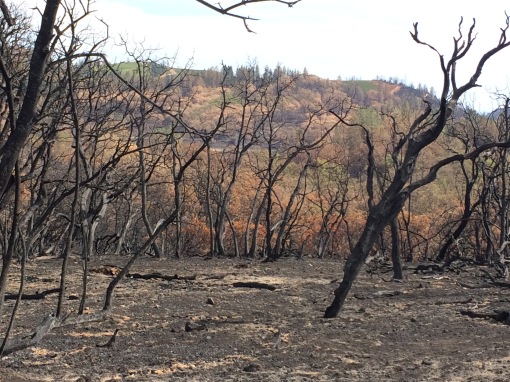
Forest devastation following the Valley Fire in Lake County. Photo taken in October 2015.
In 2015 a devastating wildfire consumed large areas of Lake County, California. Prior to the fires I had been working with some properties affected by the fires and soon afterwards I visited these areas, volunteering my time, to help guide the land managers on how best to manage their lands after the fires. Yesterday I heard back from one of my friends asking about specifics in restoring their forests. My response seems appropriate for a wider audience, so I am posting it here as general informati0n for those who have been affected by wildfires, as well as those who have not . . .
March 5, 2017
Hello,
I appreciate you reaching out for my opinion on the restoration and management of your trees and land. As you know I’ve visited your property several times in the past and have followed the work that you and others have done both before and after the devastating Valley Fire of 2015.
Regarding the challenges you face in rejuvenating your lands it is important to remember that the primary problem that has led to the decline of forests and wildfire damage has been due to the lack of significant management in most the ecosystems in and around your property. The ecosystems in your area are all fire-adapted, meaning they need periodic fires in order to remain healthy. It is clear that, in the past, the native people in your area understood this and applied fire to ecosystems in ways that promoted the health of the land, trees, and wildlife. I mention this because it is a reminder that people have long held the knowledge and skills needed to bring the modern forests in your area back to health.
Prior to the Valley Fire the pine and oak forests in Lake County were severely overgrown with brush and tree density was high. This was brought about by strict fire suppression measures during past decades. These conditions helped in the spread disease and insect pests. In the past, the repeated fires that burned were the primary way the ecosystems (with the help of native people) kept these problems in check. Now that fire has burned your lands, you have an opportunity to take a different direction in forest management.
With this in mind, let me address in general your questions on the restoration of your lands. The various species of trees all have different properties that must be considered in replanting. One of the main near-term considerations is to plant trees that will help stabilize the soils and prevent erosion and water loss in runoff. Gray pines, sugar pines, ponderosa pines, and Douglas firs are fast-growing trees that help serve to stabilize slopes. Pines are a better food source for wildlife compared to firs. The tradeoff is that tall mature pines are more prone to stem failure versus firs. Oaks are slower growing trees that take longer to mature, but they are an important part of the ecosystem, especially for wildlife.
Concern for the future health of any trees you plant rests in the way they are managed afterwards. If the trees are planted and left on their own, then in several decades the forests will return to their former state of being overgrown and in poor health. Diseases and insect pests will begin to flourish again. To avoid this, a plan must be implemented to ensure continued care of the trees. For instance, planting density may be high at first, which is needed as many seedlings will not survive. Once the trees reach sapling size there may be some necessary thinning. The healthiest trees are those that are grown in a more park-like setting, where the canopies of the trees rarely overlap. That is the long-term vision I recommend for the planting and thinning density of trees. I also recommend planting a diversity of trees, including pines, fires, oaks, and buckeyes. The oaks and the buckeyes should be planted somewhat apart from the pine and fir, as nearby conifers will overtop and shade the oaks and buckeyes. Therefore, I suggest you plant the oaks and buckeyes and other shade-intolerant trees in groves away from the conifer stands.
With regards to your specific questions:
1) Certainly it would not be best for the ecosystem to plant entirely conifers. As mentioned above, some oaks and other broad-leaved trees should be in the mix. But planting a large proportion of conifers will not be a problem in the future provided the forests are managed using prescribed fire and/or
fire mimicry methods (e.g. brush clearing, thinning, mineral fertilization). Pine beetles are part of the ecosystem and there will always be occasional losses to this pest, but bark beetles will no reach epidemic proportions as before if overcrowding is avoided.
2) I see no problem building a road on your land to assist in better management of your forests. Roads and firebreaks will be necessary to access your forests and to safely conduct any prescribed fires in the future. Of course, any road must be built in a proper way that limits erosion and creates minimal disruption to the ecosystem.
3) For the most part, thinning is preferred in the forests of your area. I cannot comment specifically unless I see the site in question. The degree of thinning depends upon density and slope characteristics. As I mentioned above, open canopy conditions (wide spaces between trees) is the preferred habitat for healthy woodlands.
I hope this information helps. Please let me know if you have any questions.
Respectfully Submitted,
Lee Klinger, MA PhD

Leave a comment